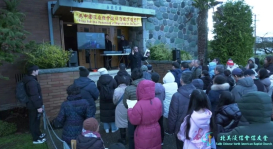
A dramatic archaeological find was uncovered in time for the Jewish Hanukkah celebrations this month.
Breaking Israel News reports that the team from the Temple Mount Sifting Project, unearthed a 1,000-year-old potsherd that they believe came from the Temple Mount. On the potsherd is a scratched out symbol that looks very similar to a menorah.
Archaeologists believe that the significant find will shed light on the actual design of the original menorahs used in the ancient holy temples.
The actual design of the menorah, as it should be, is described in the Book of Exodus (25:32-40). According to the sacred text, the pure gold menorah shall be made of hammered work while its base, stem, goblets, knobs, and flowers shall all be connected in one piece. It should have three branches on each side, but the lamps will be seven in total.
Nevertheless, rabbinic scholars over millennia have argued on whether the branches were meant to be round or straight.
The design depicted on the potsherd may finally resolve this argument once and for all. The fragmented piece shows a menorah with straight branches, and not like the popular representations that use circular ones. Archaeologists believe the base had two angular legs and one straight.
The top of the menorah has polygonal depressions for the almond shaped cups that held the oil for the wicks.
The report also mentions that the type of clay and texture of the potsherd indicates the artifact is from the Byzantine rule over Jerusalem roughly around 324-640 CE. The whole design of the menorah is not complete on the broken piece. Nevertheless, the drawing was an attempt to draw the Temple Menorah, archaeologists say.
"What makes this discovery significant is that it originated upon the Temple Mount itself. The design of the menorah upon the potsherd may shed light upon an age-old debate regarding the appearance of the menorah that stood in the Heikal (hall) of the First and Second Temples," said Zachi Dvira, co-founder and director of the project.
The official Temple Mount blog posted a picture of the potsherd that roughly measures 3 centimeters.
Bob Hathaway remarked in the comments section on Dec 08, 2015 that he thinks there are six indentations as the branches, and that the piece does appear to be a section of a larger piece. He also said that the artifact appears to be clay fired so it should be dated through carbon dating.
Nevertheless, the Temple Mount team responded that the incisions were done after the firing of the clay and that C14 dating cannot be used on the non-organic material.







